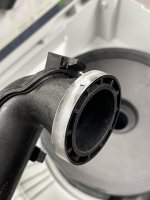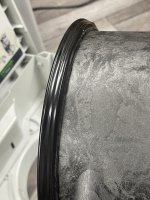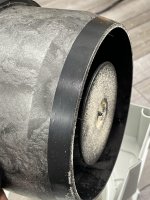silence2-38554
Member
- Joined
- Oct 3, 2021
- Messages
- 25
Hey everyone, first post here! Just yesterday I picked up a brand new CT MIDI and a VE Cyclone for my small guitar building shop. I picked both up from a local Woodcraft just in case I decided to return the cyclone, as I have read a good bit about the suction loss issues.
Unfortunately, I got everything hooked up today & while I am very impressed by the suction straight out of the MIDI, there is a noticeable drop in suction when going through the Cyclone. I very much plan on upgrading to a 36mm hose as well, but it seems the percentage of suction loss when using that hose will be even greater if using the cyclone.
With the layout of my shop, I really, really want the CT Cyclone to work out. I can't help but suspect the intersections of the black internal components. There are no gaskets or friction-fit components to speak of & everything just sort of gets pressure from the rubber bump on the underside of the lid. I understand this is probably to maintain continuity for the anti-static component of the vac, but there must be a solution!
Has anyone else taken the time to dive into this & try some experimentation to eliminate the suction loss? I have an airflow meter on order that should get delivered on Tuesday. I'll probably try making some makeshift foam rubber gaskets for the cyclone assembly to see what happens. If it works, I'll find a more elegant solution to maintain the anti-static function.
Thanks in advance for any suggestions!
Unfortunately, I got everything hooked up today & while I am very impressed by the suction straight out of the MIDI, there is a noticeable drop in suction when going through the Cyclone. I very much plan on upgrading to a 36mm hose as well, but it seems the percentage of suction loss when using that hose will be even greater if using the cyclone.
With the layout of my shop, I really, really want the CT Cyclone to work out. I can't help but suspect the intersections of the black internal components. There are no gaskets or friction-fit components to speak of & everything just sort of gets pressure from the rubber bump on the underside of the lid. I understand this is probably to maintain continuity for the anti-static component of the vac, but there must be a solution!
Has anyone else taken the time to dive into this & try some experimentation to eliminate the suction loss? I have an airflow meter on order that should get delivered on Tuesday. I'll probably try making some makeshift foam rubber gaskets for the cyclone assembly to see what happens. If it works, I'll find a more elegant solution to maintain the anti-static function.
Thanks in advance for any suggestions!



